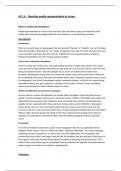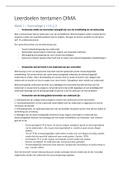AC1.4 – Describe media representation of crime.
What is media representation?
Media representation of crime is how the news, film and other sources of media like social
media show and give knowledge indirectly of an offence or crime that has occurred.
Newspapers
Introduction:
There are several types of newspapers that are deemed “Popular” or “Quality” such as The Daily
Mail, The Guardian, The Observer, etc. Major newspapers have also in recent years become easy
to access online and read upon the internet. Tabloids focus on sensationalism and drama,
whereas broadsheets are more factual and less shallow.
Type of crime reported in newspapers:
Crime is a large part of the press, one study finding that one in eight news reports were about
crime and many large tabloids maintained a large space for area of crime reports, many of them
being “sensational stories” that the tabloids use as a form of entertainment rather than
factuality. Newspapers tend to focus on crimes like violent crimes and sexual crimes, which are
less committed than crimes like theft and robbery which aren’t reported anywhere near as much
in newspapers. One third of newspaper reports contained violence, a third of the reports being
homicide involving sex, gain, jealousy or revenge as the motive. Overall, crimes containing
violence are dominant in what tabloids report on crime.
Victims and Offenders represented in newspapers:
In press reports, victims and offenders are usually older and higher status than what occurs
mostly. A lot of newspaper reports over-represent women, children, the middle class, older and
white victims to popularise their tabloid as stories involving these victims are typically more
popular stories, especially when they represent mostly males as their offenders. Newspaper
stories tend to focus on the crime itself rather than the actual causes of the crime that has
occurred, such as in rape and assault they focus on demonising that induvial that has committed
offence rather than the power men hold overall. This is like terrorism-based crimes that are
reported, the individual is demonised rather than the political background that caused the
crime.
An Example:
In the terrorist attack in Barcelona, Spain many Newspapers like the sun capitalised of the
tragedy in their reports. One sun article was titled, “Barcelona Bastards,” the violent language
capturing the eyes of audiences, as well as the use of the alliteration. The newspaper also
created the focus of the front page to not only be the headline, but also pictures of the scene of
the tragedy, with many involved laying injured mentally or physically around the street. This
violent crime took centre stage in newspaper because audience are typically more interested in
violent, tragic crime which can easily be capitalised off.
Television
, While Newspapers report on real crimes, Television demonstrates both fictional crime and real
crime news.
Crime News in Television:
TV is like tabloids in the way of they report a large quantity of violent crimes like homicide,
which is especially prominent in local news. Again, the victims and offenders are presented as
older and a higher class, the only exception being reality TV which draws in on younger
offenders.
Crime fiction in television:
A quarter of what TV show to the public is centred around crime drama. Violence is a running
theme in crime representation in the media, with two thirds of US crime drama involving
murder, armed robbery or assault. A lot of representation of murder is also factually incorrect,
with many of shows depicting the motive for murder greed based, when the typical motive for
murder is domestic conflict or conflict between younger men. This also applies to sex crime,
which media represents as committed by a mysterious, psychopathic stranger, whereas in reality
many of sex crimes are usually committed by people well-known to the victim like family or
those who the victim was or is in a relationship with. Property based crime like home robberies
are also dramatized in the media, when they’re typically less serious than demonstrated. Media
also tends to demonstrate a large proportion of victims as female, and this is usually to create an
element of sympathy and shock in viewers to boost the number of viewers. This is also
accompanied with many of the victims in these types of shows become central, making the
audience relate and identify with the victims who are centre focus. Compared with actual crime
statistics, TV crime has a quicker solving and removing from the area, but a lot of offender’s
escape in TV dramas, whereas in actuality, a lot of crimes end up with convictions- the offender
is captured. There is also an increase in police brutality and “bad cops” in TV because the media
has seen a rising trend in the dramatizing of the police force.
Examples:
The 2022 Netflix show “Dahmer,” follows the story of Jeffery Dahmer, a necrophiliac,
cannibalistic serial killer who murdered 17 young men and boys in the 70’s and 80’s. The show
has a running theme of using dark lighting and fading music in and out to dramatize the serial
killers reign of terror and the show even added extra plot points to Dahmer’s story, for example
making Dahmer’s neighbour a woman named Glenda Cleveland, who never actually met Dahmer
herself but called the police when her friends found naked, unresponsive 14-year-old Konerak
Sinthasomphone who nearly escaped his murder with Dahmer. Glenda never actually met
Dahmer, nor lived next to him, but in the Netflix series she is his neighbour and has multiple
interactions and conversations with Dahmer. This is an example of TV’s dramatization of crime
documentaries and dramas for viewing entertainment. This show also shows how the police
failed the victims of Dahmer, most notably Konerak, who after his near escape with Dahmer was
returned to Dahmer’s apartment because he convinced the police that Konerak was his 19-year-
old boyfriend, despite Konerak being 14. The police failed the victims of Dahmer because they
were mostly racial minorities and homosexual in the 80’s during the aid’s crisis, so were
neglected by the police, a demonstration of police corruption rising in TV.
Accessibility:





